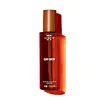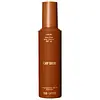What's inside
What's inside
 Key Ingredients
Key Ingredients

 Benefits
Benefits

 Concerns
Concerns

 Ingredients Side-by-side
Ingredients Side-by-side

Butyl Methoxydibenzoylmethane 3%
UV AbsorberHomosalate 10%
Skin ConditioningEthylhexyl Salicylate 5%
UV AbsorberOctocrylene 10%
UV AbsorberAlcohol
AntimicrobialC12-15 Alkyl Benzoate
AntimicrobialOctyldodecanol
EmollientDibutyl Adipate
EmollientCaprylic/Capric Triglyceride
MaskingDiethylhexyl Carbonate
EmollientDiisopropyl Sebacate
EmollientPolyester-8
Skin ConditioningLauryl Lactate
EmollientPolyamide-3
Persea Gratissima Oil
Skin ConditioningChondrus Crispus Extract
Skin ConditioningAlaria Esculenta Extract
Skin ProtectingTocopheryl Acetate
AntioxidantVitis Vinifera Seed Oil
EmollientButyrospermum Parkii Butter
Skin ConditioningArgania Spinosa Kernel Oil
EmollientCucumis Sativus Fruit Extract
EmollientHelianthus Annuus Seed Extract
Skin ConditioningHordeum Vulgare Extract
EmollientSalicornia Herbacea Extract
Skin ConditioningSqualane
EmollientGlycerin
HumectantRaphanus Sativus Seed Extract
Skin ConditioningGlycine Soja Oil
EmollientLimnanthes Alba Seed Oil
Skin ConditioningAmyris Balsamifera Bark Oil
MaskingCitrus Aurantium Amara Flower Oil
MaskingCitrus Aurantium Bergamia Fruit Oil
MaskingCoffea Arabica Seed Oil
MaskingCupressus Sempervirens Leaf/Nut/Stem Oil
EmollientHelianthus Annuus Seed Oil
EmollientMyroxylon Pereirae Oil
MaskingRosa Damascena Flower Oil
MaskingSantalum Album Oil
MaskingVanilla Planifolia Fruit Extract
Skin ConditioningDiethylhexyl Syringylidenemalonate
Skin ProtectingPentaerythrityl Tetra-Di-T-Butyl Hydroxyhydrocinnamate
AntioxidantCitric Acid
BufferingButyl Methoxydibenzoylmethane 3%, Homosalate 10%, Ethylhexyl Salicylate 5%, Octocrylene 10%, Alcohol, C12-15 Alkyl Benzoate, Octyldodecanol, Dibutyl Adipate, Caprylic/Capric Triglyceride, Diethylhexyl Carbonate, Diisopropyl Sebacate, Polyester-8, Lauryl Lactate, Polyamide-3, Persea Gratissima Oil, Chondrus Crispus Extract, Alaria Esculenta Extract, Tocopheryl Acetate, Vitis Vinifera Seed Oil, Butyrospermum Parkii Butter, Argania Spinosa Kernel Oil, Cucumis Sativus Fruit Extract, Helianthus Annuus Seed Extract, Hordeum Vulgare Extract, Salicornia Herbacea Extract, Squalane, Glycerin, Raphanus Sativus Seed Extract, Glycine Soja Oil, Limnanthes Alba Seed Oil, Amyris Balsamifera Bark Oil, Citrus Aurantium Amara Flower Oil, Citrus Aurantium Bergamia Fruit Oil, Coffea Arabica Seed Oil, Cupressus Sempervirens Leaf/Nut/Stem Oil, Helianthus Annuus Seed Oil, Myroxylon Pereirae Oil, Rosa Damascena Flower Oil, Santalum Album Oil, Vanilla Planifolia Fruit Extract, Diethylhexyl Syringylidenemalonate, Pentaerythrityl Tetra-Di-T-Butyl Hydroxyhydrocinnamate, Citric Acid
Butyl Methoxydibenzoylmethane 3%
UV AbsorberEthylhexyl Salicylate 5%
UV AbsorberOctocrylene 10%
UV AbsorberWater
Skin ConditioningC12-15 Alkyl Benzoate
AntimicrobialButyloctyl Salicylate
Skin ConditioningSodium Potassium Aluminum Silicate
Diisopropyl Sebacate
EmollientDiisopropyl Adipate
EmollientLauryl Lactate
EmollientMica
Cosmetic ColorantPropanediol
SolventGlyceryl Stearate
EmollientVp/Eicosene Copolymer
Chondrus Crispus Extract
Skin ConditioningLimonium Gerberi Extract
Skin ProtectingFerulic Acid
AntimicrobialCitrullus Lanatus Fruit Extract
Skin ConditioningPyrus Malus Fruit Extract
Skin ConditioningLens Esculenta Fruit Extract
Skin ConditioningHelianthus Annuus Seed Oil
EmollientTheobroma Cacao Seed Butter
EmollientGlycerin
HumectantCaprylic/Capric Triglyceride
MaskingCetyl Phosphate
EmulsifyingGlyceryl Stearate Citrate
EmollientSilica
AbrasiveEthylene Brassylate
MaskingCaprylyl Glycol
Emollient1,2-Hexanediol
Skin ConditioningAcrylates/C10-30 Alkyl Acrylate Crosspolymer
Emulsion StabilisingAminomethyl Propanol
BufferingSodium Lactate
BufferingSodium PCA
HumectantSodium Benzoate
MaskingPotassium Sorbate
PreservativeDisodium EDTA
Chlorphenesin
AntimicrobialSynthetic Fluorphlogopite
Tin Oxide
AbrasiveCI 77891
Cosmetic ColorantCI 77491
Cosmetic ColorantButyl Methoxydibenzoylmethane 3%, Ethylhexyl Salicylate 5%, Octocrylene 10%, Water, C12-15 Alkyl Benzoate, Butyloctyl Salicylate, Sodium Potassium Aluminum Silicate, Diisopropyl Sebacate, Diisopropyl Adipate, Lauryl Lactate, Mica, Propanediol, Glyceryl Stearate, Vp/Eicosene Copolymer, Chondrus Crispus Extract, Limonium Gerberi Extract, Ferulic Acid, Citrullus Lanatus Fruit Extract, Pyrus Malus Fruit Extract, Lens Esculenta Fruit Extract, Helianthus Annuus Seed Oil, Theobroma Cacao Seed Butter, Glycerin, Caprylic/Capric Triglyceride, Cetyl Phosphate, Glyceryl Stearate Citrate, Silica, Ethylene Brassylate, Caprylyl Glycol, 1,2-Hexanediol, Acrylates/C10-30 Alkyl Acrylate Crosspolymer, Aminomethyl Propanol, Sodium Lactate, Sodium PCA, Sodium Benzoate, Potassium Sorbate, Disodium EDTA, Chlorphenesin, Synthetic Fluorphlogopite, Tin Oxide, CI 77891, CI 77491
Ingredients Explained
These ingredients are found in both products.
Ingredients higher up in an ingredient list are typically present in a larger amount.
Also known as Avobenzone, this ingredient is a chemical sunscreen filter that provides protection in the UV-A range.
Avobenzone is globally approved and is the most commonly used UV-A filter in the world.
Studies have found that avobenzone becomes ineffective when exposed to UV light (it is not photostable; meaning that it breaks down in sunlight). Because of this, formulations that include avobenzone will usually contain stabilizers such as octocrylene.
However, some modern formulations (looking at you, EU!) are able to stabilize avobenzone by coating the molecules.
Avobenzone does not protect against the UV-B range, so it's important to check that the sunscreen you're using contains other UV filters that do!
The highest concentration of avobenzone permitted is 3% in the US, and 5% in the EU.
Learn more about Butyl MethoxydibenzoylmethaneC12-15 Alkyl Benzoate is made up of Benzoic Acid and long chain alcohols. It has a low molecular weight.
C12-15 Alkyl Benzoate is an emollient and texture enhancer. Due to its solubility, it is often used in sunscreens to help evenly distribute active ingredients.
As an emollient, C12-15 Alkyl Benzoate helps soften and hydrate your skin. Emollients create a film on your skin that traps moisture within.
This ingredient has been reported to cause eye irritation.
Learn more about C12-15 Alkyl BenzoateThis ingredient is an emollient, solvent, and texture enhancer. It is considered a skin-softener by helping the skin prevent moisture loss.
It helps thicken a product's formula and makes it easier to spread by dissolving clumping compounds.
Caprylic Triglyceride is made by combining glycerin with coconut oil, forming a clear liquid.
While there is an assumption Caprylic Triglyceride can clog pores due to it being derived from coconut oil, there is no research supporting this.
Learn more about Caprylic/Capric TriglycerideChondrus Crispus Extract comes from a red algae native to the northern Atlantic coasts of Europe and North America. It helps hydrate the skin and is rich in antioxidants.
The antioxidants in chondrus crispus include lutein and zeaxanthin. Lutein has the ability to filter blue light from screens.
Other contents of chondrus crispus include polysaccharides, peptides, and amino acids. These help hydrate the skin.
What's the difference between algae and seaweed?
Algae is a broad term that includes seaweed. Not all algae is seaweed.
We don't have a description for Diisopropyl Sebacate yet.
Ethylhexyl Salicylate is an organic compound used to block UV rays. It primarily absorbs UVB rays but offers a small amount of UVA protection as well.
Commonly found in sunscreens, Ethylhexyl Salicylate is created from salicylic acid and 2-ethylhexanol. You might know salicylic acid as the effective acne fighter ingredient and BHA.
The ethylhexanol in this ingredient is a fatty alcohol and helps hydrate your skin, similar to oils. It is an emollient, which means it traps moisture into the skin.
According to manufacturers, Ethylhexyl Salicylate absorbs UV wavelength of 295-315 nm, with a peak absorption at 307-310 nm. UVA rays are linked to long term skin damage, such as hyperpigmentation. UVB rays emit more energy and are capable of damaging our DNA. UVB rays cause sunburn.
Learn more about Ethylhexyl SalicylateGlycerin is already naturally found in your skin. It helps moisturize and protect your skin.
A study from 2016 found glycerin to be more effective as a humectant than AHAs and hyaluronic acid.
As a humectant, it helps the skin stay hydrated by pulling moisture to your skin. The low molecular weight of glycerin allows it to pull moisture into the deeper layers of your skin.
Hydrated skin improves your skin barrier; Your skin barrier helps protect against irritants and bacteria.
Glycerin has also been found to have antimicrobial and antiviral properties. Due to these properties, glycerin is often used in wound and burn treatments.
In cosmetics, glycerin is usually derived from plants such as soybean or palm. However, it can also be sourced from animals, such as tallow or animal fat.
This ingredient is organic, colorless, odorless, and non-toxic.
Glycerin is the name for this ingredient in American English. British English uses Glycerol/Glycerine.
Learn more about GlycerinHelianthus Annuus Seed Oil is the oil derived from the seeds of a Sunflower. Sunflower seed oil is non-fragrant. It is an emollient, meaning it helps to soften the skin.
Sunflower seed oil contains many fatty acids. The fatty acids found in sunflower seeds include (from highest amount to least): linoleic acid, myristic acid, palmitic acid, stearic acid, arachidic acid, oleic acid, and linolenic acid.
These fatty acids help the skin create ceramides. Ceramides play a role in repairing the skin barrier.
Helianthus Annuus Seed Oil helps moisturize the skin. This in turn helps the skin look more rejuvenated and smoother.
Sunflowers are rich in vitamin E.
Historians believe Indigenous cultures of North America domesticated sunflowers before corn. Thus they relied on sunflower oil for a variety of uses. One such use is moisturizing skin and hair.
Sunflower seed oil may not be fungal acne safe. We recommend speaking with a professional if you have any concerns.
Learn more about Helianthus Annuus Seed OilLauryl Lactate, AKA koplactate, is an ester of lauryl alcohol and lactic acid. It is considered a mild AHA derivative.
This ingredient has emollient, skin conditioning, and very gentle exfoliating properties. According to a manufacturer, it can act as a penetration enhancer for active ingredients.
Octocrylene protects skin from sun damage. It absorbs UV-B with peak absorption of 304 nm. It is a common sunscreen ingredient and often paired with avobenzone, a UVA filter. This is because octocrylene stabilizes other sunscreen ingredients by protecting them from degradation when exposed to sunlight. Octocrylene is a photostable ingredient and loses about 10% of SPF in 95 minutes.
Octocrylene also acts as an emollient, meaning it helps skin retain moisture and softens skin. It is oil-soluble and hydrophobic, enhancing water-resistant properties in a product.
Those who are using ketoprofen, a topical anti-inflammatory drug, may experience an allergic reaction when using octocrylene. It is best to speak with a healthcare professional about using sunscreens with octocrylene.
The EU allows a maximum of these concentrations:
Learn more about Octocrylene